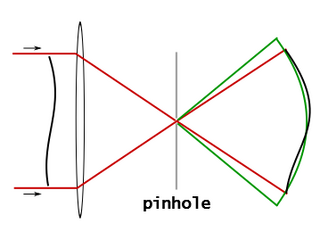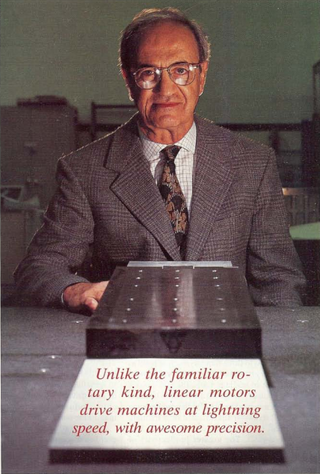
Interferometry is a technique which uses the interference of superimposed waves to extract information. Interferometry typically uses electromagnetic waves and is an important investigative technique in the fields of astronomy, fiber optics, engineering metrology, optical metrology, oceanography, seismology, spectroscopy, quantum mechanics, nuclear and particle physics, plasma physics, biomolecular interactions, surface profiling, microfluidics, mechanical stress/strain measurement, velocimetry, optometry, and making holograms.
Optics is the branch of physics which involves the behavior and properties of light, including its interactions with matter and the construction of instruments that use or detect it. Optics usually describes the behavior of visible, ultraviolet, and infrared light. Because light is an electromagnetic wave, other forms of electromagnetic radiation such as X-rays, microwaves, and radio waves exhibit similar properties.

Optical engineering is the field of engineering encompassing the physical phenomena and technologies associated with the generation, transmission, manipulation, detection, and utilization of light. Optical engineers use the science of optics to solve problems and to design and build devices that make light do something useful. They design and operate optical equipment that uses the properties of light using physics and chemistry, such as lenses, microscopes, telescopes, lasers, sensors, fiber-optic communication systems and optical disc systems.

The Michelson interferometer is a common configuration for optical interferometry and was invented by the 19/20th-century American physicist Albert Abraham Michelson. Using a beam splitter, a light source is split into two arms. Each of those light beams is reflected back toward the beamsplitter which then combines their amplitudes using the superposition principle. The resulting interference pattern that is not directed back toward the source is typically directed to some type of photoelectric detector or camera. For different applications of the interferometer, the two light paths can be with different lengths or incorporate optical elements or even materials under test.

Optical coherence tomography (OCT) is an imaging technique that uses interferometry with short-coherence-length light to obtain micrometer-level depth resolution and uses transverse scanning of the light beam to form two- and three-dimensional images from light reflected from within biological tissue or other scattering media. Short-coherence-length light can be obtained using a superluminescent diode (SLD) with a broad spectral bandwidth or a broadly tunable laser with narrow linewidth. The first demonstration of OCT imaging was published by a team from MIT and Harvard Medical School in a 1991 article in the journal Science. The article introduced the term "OCT" to credit its derivation from optical coherence-domain reflectometry, in which the axial resolution is based on temporal coherence. The first demonstrations of in vivo OCT imaging quickly followed.

The Navy Precision Optical Interferometer (NPOI) is an American astronomical interferometer, with the world's largest baselines, operated by the Naval Observatory Flagstaff Station (NOFS) in collaboration with the Naval Research Laboratory (NRL) and Lowell Observatory. The NPOI primarily produces space imagery and astrometry, the latter a major component required for the safe position and navigation of all manner of vehicles for the DoD. The facility is located at Lowell's Anderson Mesa Station on Anderson Mesa about 25 kilometers (16 mi) southeast of Flagstaff, Arizona (US). Until November 2011, the facility was known as the Navy Prototype Optical Interferometer (NPOI). Subsequently, the instrument was temporarily renamed the Navy Optical Interferometer, and now permanently, the Kenneth J. Johnston Navy Precision Optical Interferometer (NPOI) – reflecting both the operational maturity of the facility, and paying tribute to its principal driver and retired founder, Kenneth J. Johnston.

The Sagnac effect, also called Sagnac interference, named after French physicist Georges Sagnac, is a phenomenon encountered in interferometry that is elicited by rotation. The Sagnac effect manifests itself in a setup called a ring interferometer or Sagnac interferometer. A beam of light is split and the two beams are made to follow the same path but in opposite directions. On return to the point of entry the two light beams are allowed to exit the ring and undergo interference. The relative phases of the two exiting beams, and thus the position of the interference fringes, are shifted according to the angular velocity of the apparatus. In other words, when the interferometer is at rest with respect to a nonrotating frame, the light takes the same amount of time to traverse the ring in either direction. However, when the interferometer system is spun, one beam of light has a longer path to travel than the other in order to complete one circuit of the mechanical frame, and so takes longer, resulting in a phase difference between the two beams. Georges Sagnac set up this experiment in 1913 in an attempt to prove the existence of the aether that Einstein's theory of special relativity makes superfluous.

An astronomical interferometer or telescope array is a set of separate telescopes, mirror segments, or radio telescope antennas that work together as a single telescope to provide higher resolution images of astronomical objects such as stars, nebulas and galaxies by means of interferometry. The advantage of this technique is that it can theoretically produce images with the angular resolution of a huge telescope with an aperture equal to the separation, called baseline, between the component telescopes. The main drawback is that it does not collect as much light as the complete instrument's mirror. Thus it is mainly useful for fine resolution of more luminous astronomical objects, such as close binary stars. Another drawback is that the maximum angular size of a detectable emission source is limited by the minimum gap between detectors in the collector array.
Optical manufacturing and testing is the process of manufacturing and testing optical components. It spans a wide range of manufacturing procedures and optical test configurations.

A Fizeau interferometer is an interferometric arrangement whereby two reflecting surfaces are placed facing each other. As seen in Fig 1, the rear-surface reflected light from the transparent first reflector is combined with front-surface reflected light from the second reflector to form interference fringes.

A point diffraction interferometer (PDI) is a type of common-path interferometer. Unlike an amplitude-splitting interferometer, such as a Michelson interferometer, which separates out an unaberrated beam and interferes this with the test beam, a common-path interferometer generates its own reference beam. In PDI systems, the test and reference beams travel the same or almost the same path. This design makes the PDI extremely useful when environmental isolation is not possible or a reduction in the number of precision optics is required. The reference beam is created from a portion of the test beam by diffraction from a small pinhole in a semitransparent coating. The principle of a PDI is shown in Figure 1.

McPherson is a custom manufacturer of precision optical instruments and systems for measuring and characterizing spectra. McPherson instruments measure intensity vs. frequency in various regions of the electromagnetic spectrum. McPherson’s spectral test instruments are based on the dispersing properties of a diffraction grating and/or refractive prism.
The N-slit interferometer is an extension of the double-slit interferometer also known as Young's double-slit interferometer. One of the first known uses of N-slit arrays in optics was illustrated by Newton. In the first part of the twentieth century, Michelson described various cases of N-slit diffraction.

A white light scanner (WLS) is a device for performing surface height measurements of an object using coherence scanning interferometry (CSI) with spectrally-broadband, "white light" illumination. Different configurations of scanning interferometer may be used to measure macroscopic objects with surface profiles measuring in the centimeter range, to microscopic objects with surface profiles measuring in the micrometer range. For large-scale non-interferometric measurement systems, see structured-light 3D scanner.
Novacam Technologies Inc. specializes in designing and manufacturing advanced metrology and imaging systems for industrial and bio-medical applications. Novacam's fiber-based optical profilometers and Optical Coherence Tomography (OCT) systems are based on low coherence interferometry. The fiber-based nature of Novacam's detector probes is unique in the optical metrology industry.
A common-path interferometer is a class of interferometers in which the reference beam and sample beams travel along the same path. Examples include the Sagnac interferometer, Zernike phase-contrast interferometer, and the point diffraction interferometer. A common-path interferometer is generally more robust to environmental vibrations than a "double-path interferometer" such as the Michelson interferometer or the Mach–Zehnder interferometer. Although travelling along the same path, the reference and sample beams may travel along opposite directions, or they may travel along the same direction but with the same or different polarization.
Taylor Hobson is an English company founded in 1886 and located in Leicester, England. Originally a manufacturer of still camera and cine lenses, the company now manufactures precision metrology instruments—in particular, profilometers for the analysis of surface textures and forms.
AMETEK, Inc. is an American multinational conglomerate and global designer and manufacturer of electronic instruments and electromechanical devices with headquarters in the United States and over 220 sites worldwide.
Walter Thompson Welford was a British physicist with expertise in optics.

Anwar Chitayat is the founder and former CEO and chairman of Anorad Corp., which was acquired in 1998 by Rockwell Automation. Mr. Chitayat holds over 95 patents in Electronics, Semiconductors and Automation including Nanotechnology, Interferometry and Linear motors. His achievements in High technology were honored by SEMI in 2000 at their highest honor for Lifetime Achievement, reserved for individuals who repeatedly enable and lead the technology industry throughout their professional career. In 1997, Anwar was awarded the Entrepreneur of the year award by Ernst and Young, and in 2009, Anwar was inducted to Long Island Hall of Fame for his impacts on science and technology on Long Island.












